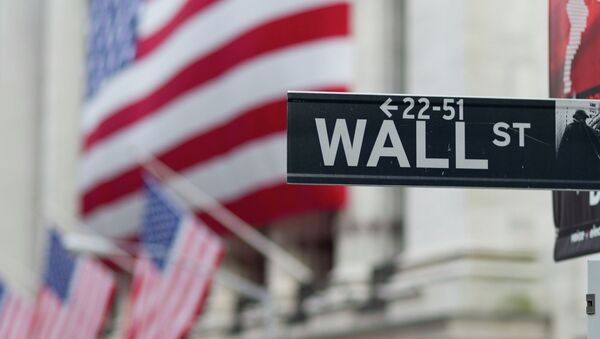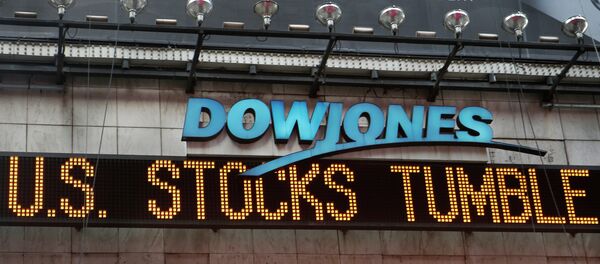Trading on Wall Street was in the green most of the day on Tuesday, however, the last hour of trading was a frantic selloff, with all three major stock indices dropping 1.29% on the average. Fragile hopes for markets recovery were crushed by a yet another round of mainland China currency tweaking, with the People’s Bank of China (PBOC) pouring some 150 bln renminbi ($23.40 bln) into the nation’s financial system. PBOC’s intervention was another half-hearted attempt at monetary easing, though hardly helpful, but further exacerbating the situation in Asia-Pacific currency markets.
The Dow Jones Industrial Average set a yet another record. Having dropped 204.91 points (1.29%) to 15,666.44, the index posted a fourth consecutive session of massive losses. During the day, the Dow rose to as high as 16,224 points. The subsequent slump in the 30-stock measure was the worst in four years.
The S&P 500 Index also swang between 2.9% gains in the midday, settling 1.9% down at 1,867.61 points. The tech-driven Nasdaq Index posted less significant losses, down 0.44% at 4,506.49.
While investors are jumpy amidst the eruption of market volatility, the main risk to US equities is generated overseas, meaning more significant domestic developments, like Fed interest rate action or macro data, will eventually prevail determining market sentiment.
While some $2 trln exited US shares since last Wednesday in a 10-percent adjustment to a slower expansion in the non-financial sector, not all of this money is a sheer waste. A significant portion of these funds ended up in fixed income (the US bonds). Also, select investors managed to capitalize on Tuesday’s gains, selling at the day’s top after the Chinese news.
First, the US bond extended their massive rally due to the equities selloff, posting their one-week highest without yield losses. Actually, the yield on a 10-year note rose 13.6 basis points, having broken through the 2% ceiling earlier in the day, ending at 2.133% after the biggest one-day gain since 5 July, 2013. The yield on 2-year note rose 7.3 basis points to 0.641%, while the 30-year yield added 12.9 basis points to 2.848%.
Treasury yield rise usually indicate a lot of selling pressure in the bond market. However, this is not the case now. US Treasury futures posted the week’s steepest rise amidst solid demand for US debt. 10-year futures contracts for September rose 19/32 to 128 21/32, adding $5.94 per $1,000 face amount. The multi-month rally in US debt saw Treasuries appreciate 0.6% thus far in August after a rise of 1.2% the previous month. That said, not only the US government is attracting more money with its safe-haven market reputation, but bondholders are also gaining. The biggest of the latter is the US Fed, preparing for a rate hike, while Japan, the largest overseas holder of US debt, is also capitalizing.
Second, before Tuesday’s selloff started at about 2 PM in New York, most sectors of equity market were in the green, meaning the subsequent slump turned out to be lucrative to certain market participants. In the S&P 500, every industry group ended lower, but greatest amount of celling bets was in the utilities, telecommunications, commodities and financials. While the oil-related sectors are obviously on the losing streak, solid US macro data provide them a boost time after time, creating the right selling opportunity. Lower commercial returns anticipated due to a stronger dollar, weaker renminbi and cheaper oil urge investors to cut their equity positions, but optimistic data spawn occasional buying bets. All that said, the US market situation is not a crash, it is rather a large downward bargain.
After 7% to 10% retreat on Wall Street in a first correction since 2011, the market is at the levels where JP Morgan Chase recommends buying. However, given weak positions of energy companies, exporters and multinationals, the downward trend is likely to prevail a while longer. While trading volumes are heavy, with 10.4 bln equities bought and sold (monthly average is 7.5 bln), there are a lot of opportunities to extract profits. On the NYSE, the amount of dropping stocks was 1,721, while some 1,384 stock rose, most prominently, the electronics retailer Best Buy (up 12.57%) after a sudden increase in quarterly sales. Nasdaq was more balanced, with 1,480 stocks declining and 1,379 advancing.
The situation is far from being a full-blown crash. As impact of the overseas risks wanes, a more coherent flat movement in US stocks will prevail, in line with the mediocre expansion in real eceonomy.




